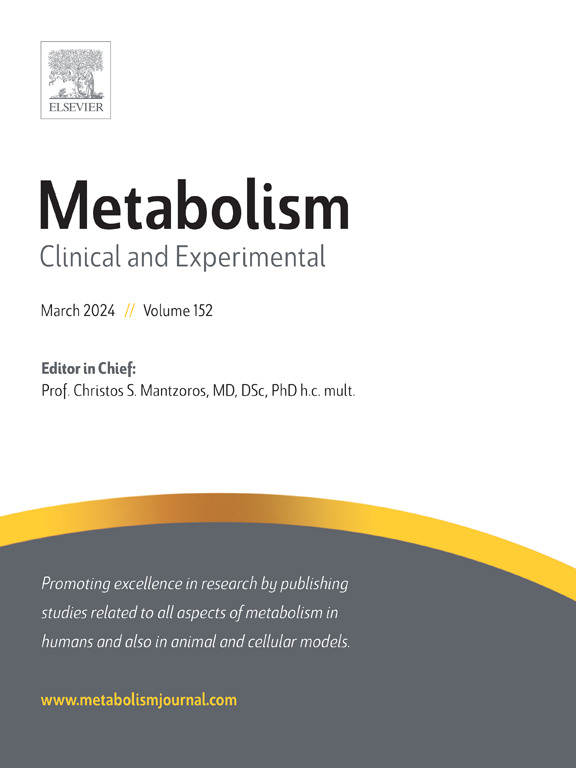Targeting endoplasmic reticulum stress as a potential therapeutic strategy for diabetic cardiomyopathy
IF 10.8
1区 医学
Q1 ENDOCRINOLOGY & METABOLISM
引用次数: 0
Abstract
Endoplasmic reticulum (ER) is an essential organelle involved in vesicular transport, calcium handling, protein synthesis and folding, and lipid biosynthesis and metabolism. ER stress occurs when ER homeostasis is disrupted by the accumulation of unfolded and/or misfolded proteins in the ER lumen. Adaptive pathways of the unfolded protein response (UPR) are activated to maintain ER homeostasis. In obesity and type 2 diabetes mellitus (T2DM), accumulating data indicate that persistent ER stress due to maladaptive UPR interacts with insulin/leptin signaling, which may be the potential and central mechanistic link between obesity-/T2DM-induced metabolic dysregulation (chronic hyperglycemia, dyslipidemia and lipotoxicity in cardiomyocytes), insulin/leptin resistance and the development of diabetic cardiomyopathy (DiabCM). Meanwhile, these pathological conditions further exacerbate ER stress. However, their interrelationships and the underlying molecular mechanisms are not fully understood. A deeper understanding of ER stress-mediated pathways in DiabCM is needed to develop novel therapeutic strategies. The aim of this review is to discuss the crosstalk between ER stress and leptin/insulin signaling and their involvement in the development of DiabCM focusing on mitochondria-associated ER membranes and chronic inflammation. We also present the current direction of drug development and important considerations for translational research into targeting ER stress for the treatment of DiabCM.
将内质网应激作为糖尿病心肌病的潜在治疗策略。
内质网(ER)是一个重要的细胞器,参与囊泡运输、钙处理、蛋白质合成和折叠以及脂质的生物合成和代谢。当未折叠和/或折叠错误的蛋白质在ER腔内积累而破坏ER平衡时,就会发生ER应激。未折叠蛋白反应(UPR)的适应途径被激活,以维持ER平衡。在肥胖和 2 型糖尿病(T2DM)中,不断积累的数据表明,不适应性 UPR 导致的持续性 ER 应激与胰岛素/瘦素信号传导相互作用,这可能是肥胖/T2DM 导致的代谢失调(心肌细胞中的慢性高血糖、血脂异常和脂毒性)、胰岛素/瘦素抵抗和糖尿病心肌病(DiabCM)发展之间潜在的核心机制联系。同时,这些病理条件进一步加剧了ER应激。然而,它们之间的相互关系和潜在的分子机制尚未完全明了。要开发新的治疗策略,就需要更深入地了解 DiabCM 中ER 应激介导的途径。本综述旨在讨论 ER 应激与瘦素/胰岛素信号之间的相互影响,以及它们在 DiabCM 发病过程中的参与,重点关注线粒体相关 ER 膜和慢性炎症。我们还介绍了当前药物开发的方向,以及针对治疗 DiabCM 的 ER 应激进行转化研究的重要考虑因素。
本文章由计算机程序翻译,如有差异,请以英文原文为准。
求助全文
约1分钟内获得全文
求助全文
来源期刊

Metabolism: clinical and experimental
医学-内分泌学与代谢
CiteScore
18.90
自引率
3.10%
发文量
310
审稿时长
16 days
期刊介绍:
Metabolism upholds research excellence by disseminating high-quality original research, reviews, editorials, and commentaries covering all facets of human metabolism.
Consideration for publication in Metabolism extends to studies in humans, animal, and cellular models, with a particular emphasis on work demonstrating strong translational potential.
The journal addresses a range of topics, including:
- Energy Expenditure and Obesity
- Metabolic Syndrome, Prediabetes, and Diabetes
- Nutrition, Exercise, and the Environment
- Genetics and Genomics, Proteomics, and Metabolomics
- Carbohydrate, Lipid, and Protein Metabolism
- Endocrinology and Hypertension
- Mineral and Bone Metabolism
- Cardiovascular Diseases and Malignancies
- Inflammation in metabolism and immunometabolism
 求助内容:
求助内容: 应助结果提醒方式:
应助结果提醒方式:


